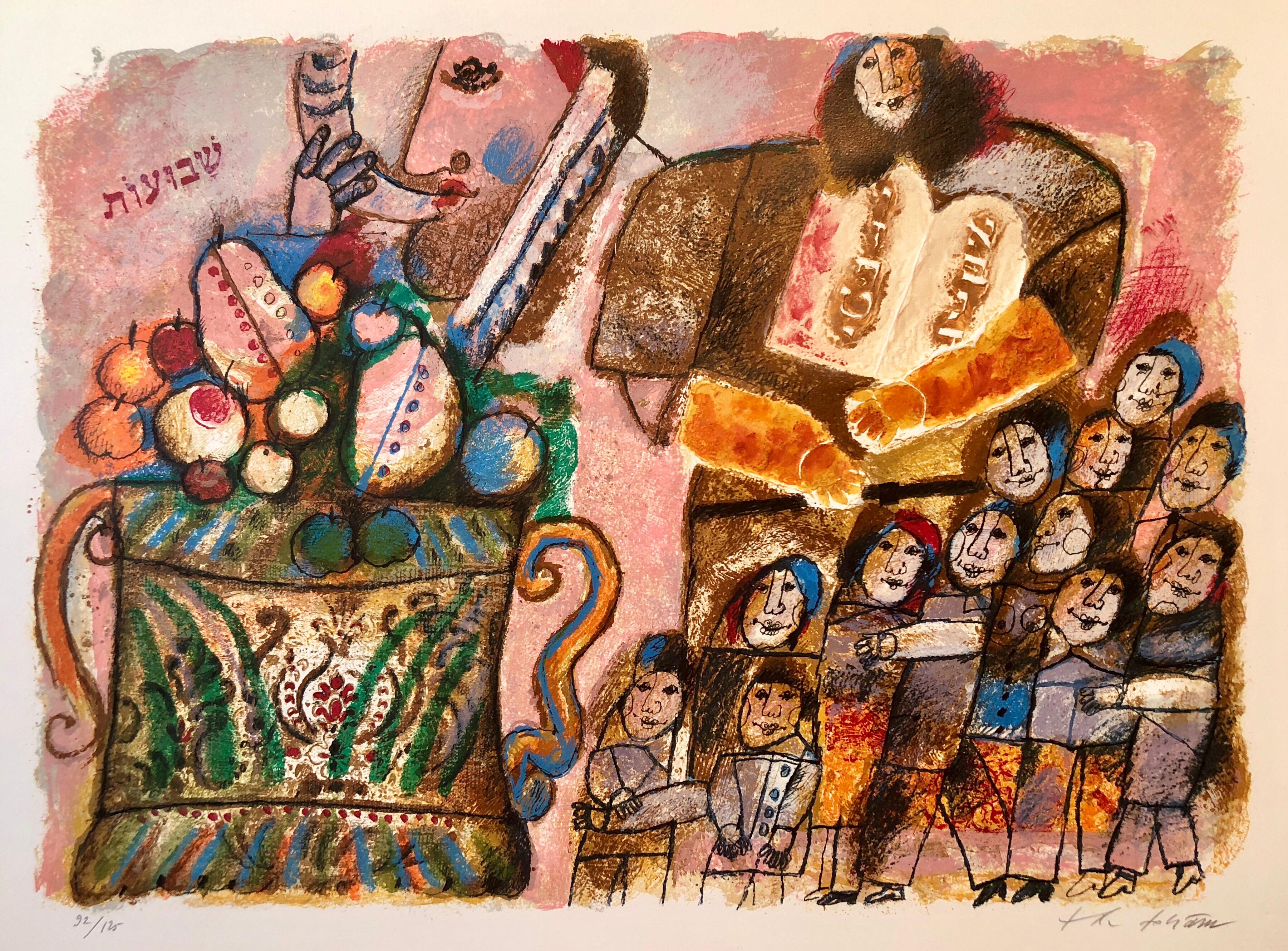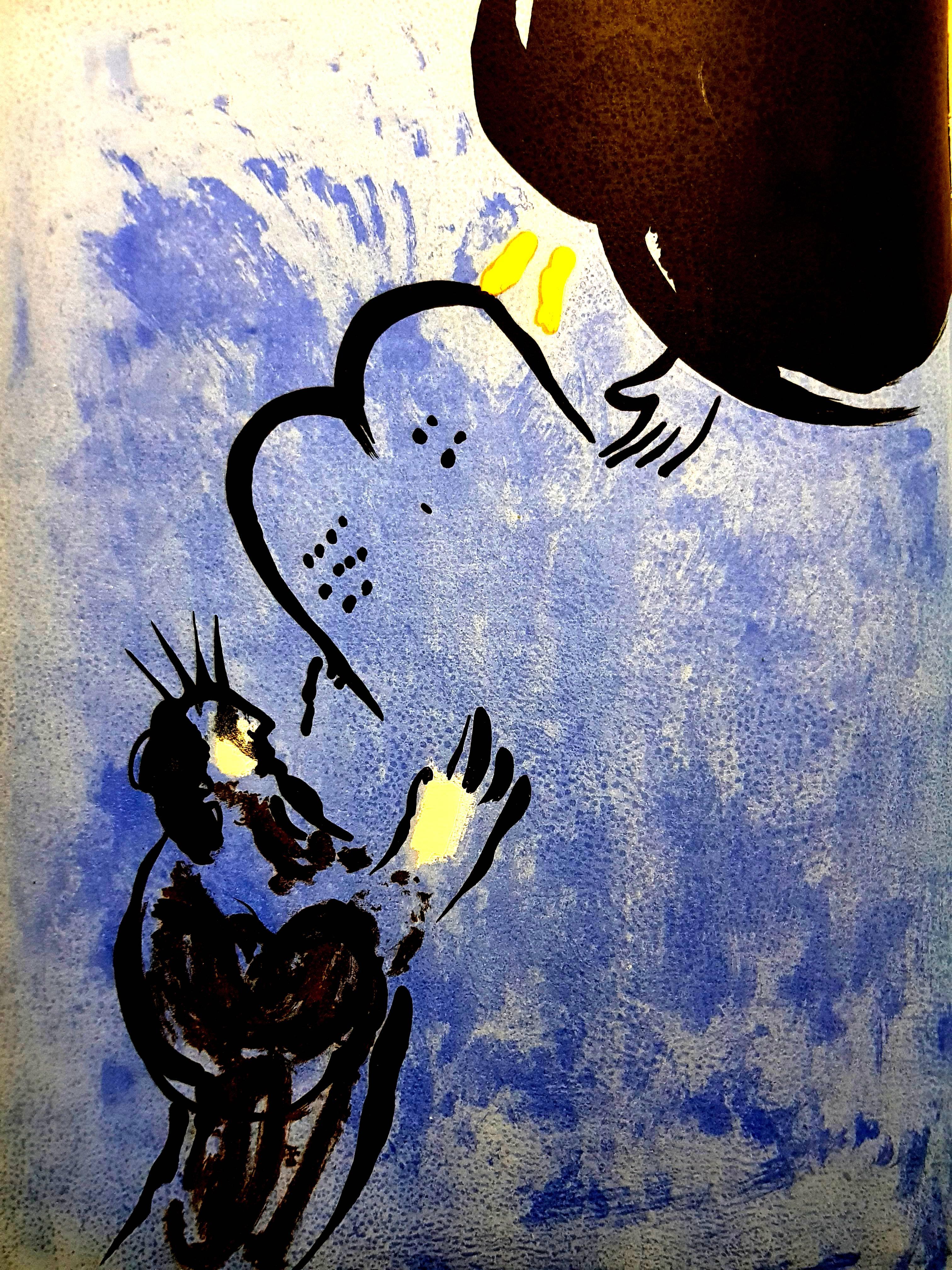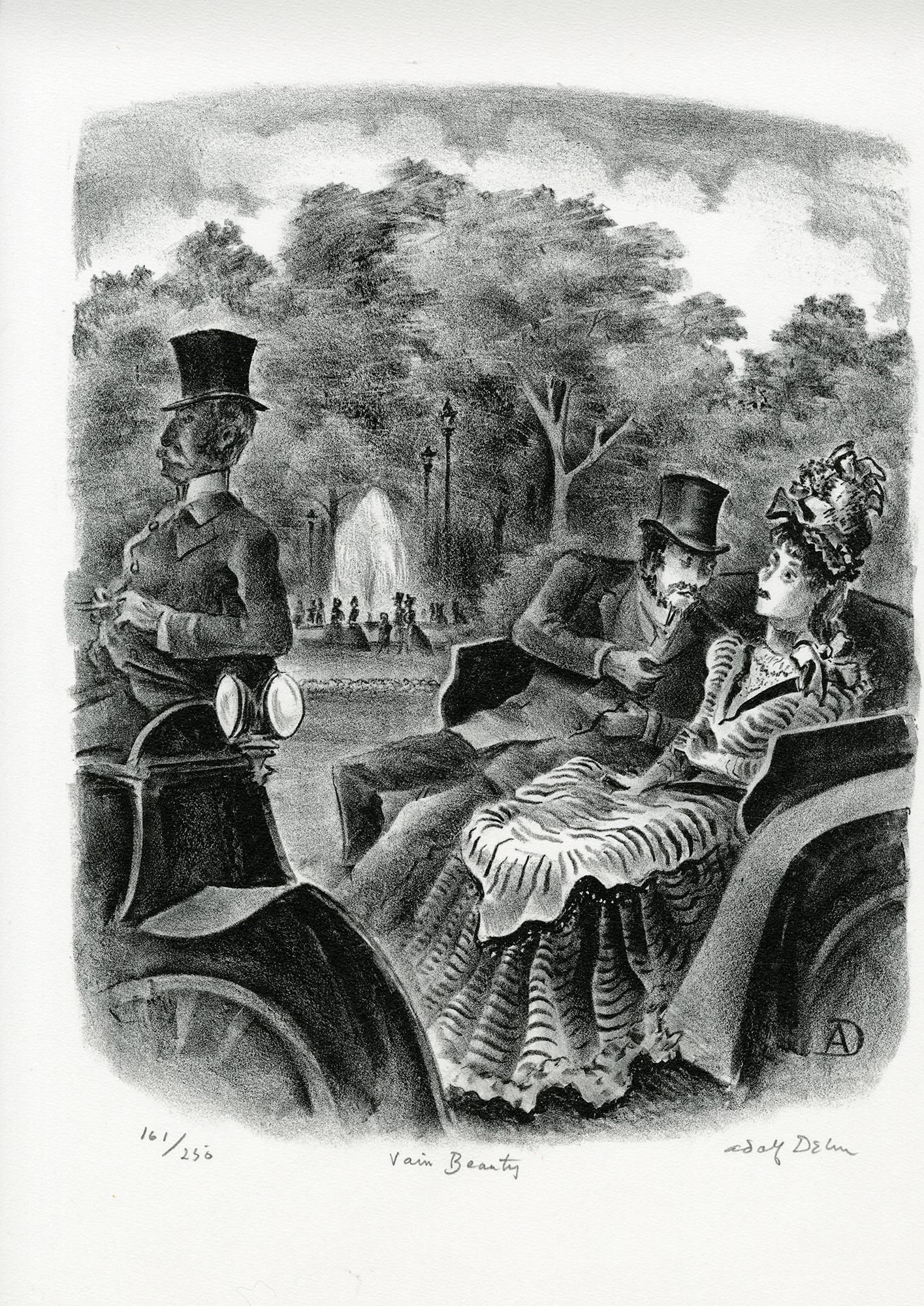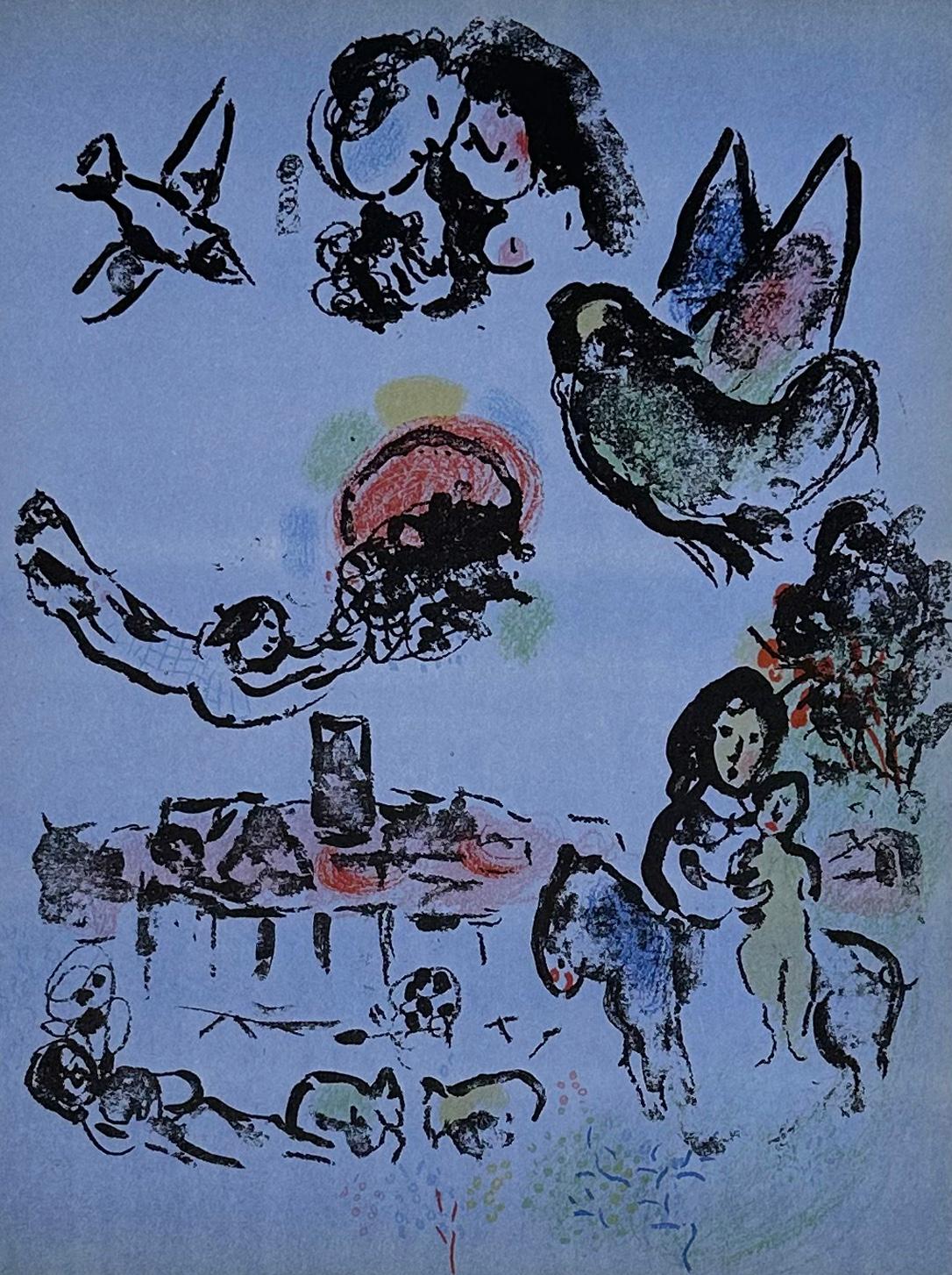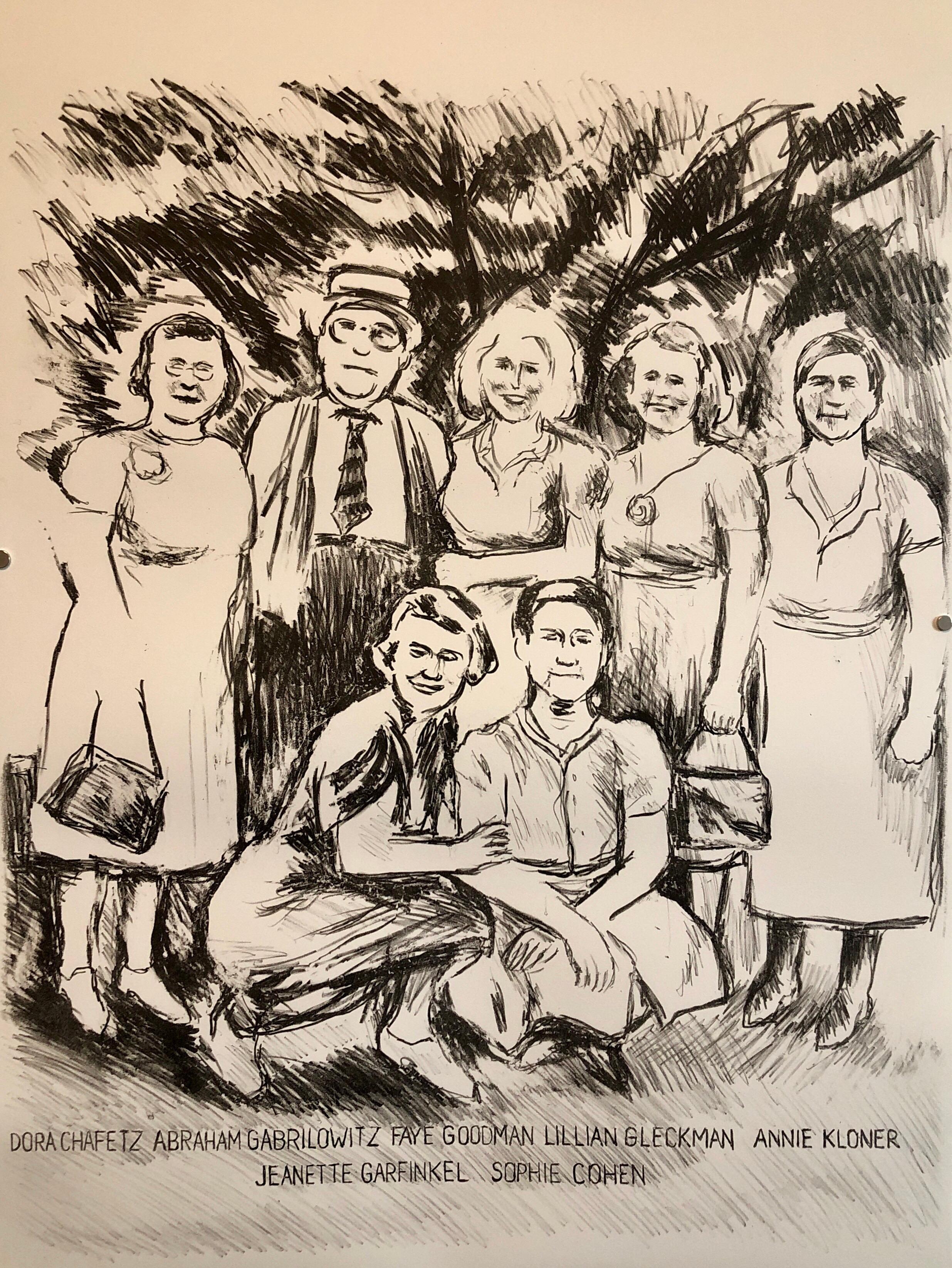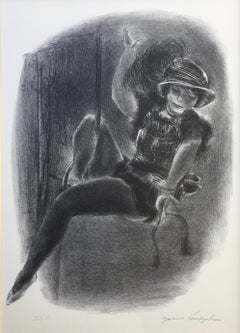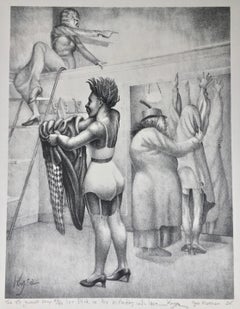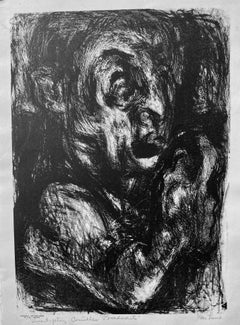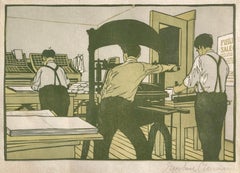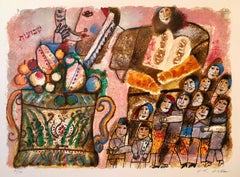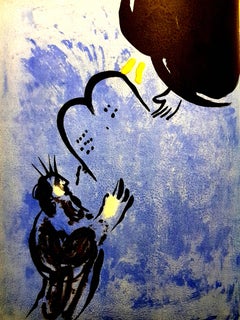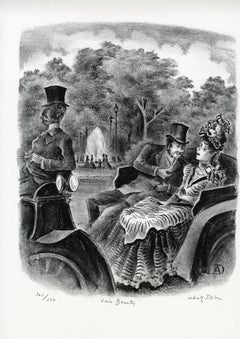Items Similar to WHAT DOES ART MEAN HERE? - WAS HEISST HIER KUNST?
Want more images or videos?
Request additional images or videos from the seller
1 of 11
Andreas Paul WeberWHAT DOES ART MEAN HERE? - WAS HEISST HIER KUNST?c. 1953
c. 1953
About the Item
ANDREAS PAUL WEBER (German 1893-1980)
WAS HEISST HIER KUNST? (WHAT DOES ART MEAN HERE?) c 1953
Lithograph, signed in pencil and with the artist's Clan Press Stamp lower left corner. Image including the light PRINTED BORDER AROUND THE IMAGE is 15 1/2 x 18 3/4 inches. The full sheet 19 3/4 x 24 1/2 inches with deckle edges.. IN VERY GOOD CONDITION. SHEET FRESH AND EVEN - PHOTO IS TOO DARK!!
An image of EDVARD MUNCH''S "THE SCREAM" is below a satirical image of a man eating a sausage sitting on top of other works of art including - GOYA"S "SLEEP OF REASON" at the lower right corner
The A. Paul Weber Museum was inaugurated in Ratzeburg in 1973. Andreas Paul Weber died on 9 November 1980. This important German lithographer, draughtsman and painter bequeathed a comprehensive œuvre, in which critical satirical works figure prominently.
THE WEBER MUSEUM HAS ADDITIONAL INFORMATION AND A BIOGRAPHY
The following is a biography taken from the prominent German auction house KETTERER / KUNST:
"Andreas Paul Weber attended secondary modern school in Arnstadt between 1903 and 1910 before briefly attending the School for the Decorative and Applied Arts in Erfurt. In 1908 Weber joined the 'Jungwandervogel', a movement which sought to develop a new, modern lifestyle based on walking and living close to nature. At the same time Andreas Paul Weber began experimenting with lithography and worked as a commercial artist. When the first world war broke out, Weber served as a railway engineer on the Eastern Front, where he worked for the army as a draughtsman from 1916. After the war Andreas Paul Weber illustrated numerous books, including Till Eulenspiegel, Reineke Fuchs and the critical contemporary work Der Zeitgenosse by Hjalmar Kutzleb, which were Weber's first successes. In 1925 Weber founded the 'Clan-Presse' ['Clan Press'], where he and his son Christian printed seals, ex libris labels and commercial graphics. In 1928 Weber joined the 'resistance circle' against the growing threat posed by National Socialism. Between 1931 and 1936 Weber and Ernst Niekisch published the journal 'Widerstand' ['Resistance'] and Weber also did satirical political illustrations and book illustrations for the 'Widerstands-Verlag' publishing house. Weber settled at Schretstaken near Mölln and became acquainted with Johannes Böse, who was head of the 'Griffelkunst-Vereinigung' in Hamburg. However, Weber was arrested by the Gestapo in connection with general persecution of the 'Resistance Circle' and sent to Hamburg-Fuhlsbüttel concentration camp. He was later imprisoned in Berlin and Nuremberg. There he permitted to draw, provided his work was apolitical, and he did his first 'Schachspieler' ['Chess Players']. After a trip to Florida in winter 1938/39, Weber became a regular contributor of lithographs to the 'Griffelkunst-Vereinigung', for which he had done one hundred and fifty lithographs by 1980. In 1939-41 Weber did the 'Leviathan' and 'Reichtum aus Tränen' ['A Richness of Tears'] cycles, which were published by the Nibelungen Verlag in Berlin as 'Britische Bilder' ['British Pictures']. Weber was called up to serve in the second world war. After the war he again did critical lithographs dealing with contemporary themes and also worked at the satirical magazine 'Simplicissimus' from 1954 to 1967. Increasing recognition came to Weber's work: in 1951 the 'Griffelkunst-Vereinigung' founded an 'A.-Paul-Weber Circle', which also made him financially secure; in 1955 Weber was awarded the Schleswig-Holstein Art Prize and, in 1963, the Hans Thoma Medal. In 1971 he was officially designated professor and decorated with the Grand Federal Service Cross. Weber showed his work at numerous large international exhibitions."
- Creator:Andreas Paul Weber (1893 - 1980, German)
- Creation Year:c. 1953
- Dimensions:Height: 18.25 in (46.36 cm)Width: 23.25 in (59.06 cm)
- Medium:
- Movement & Style:
- Period:
- Condition:
- Gallery Location:Santa Monica, CA
- Reference Number:1stDibs: LU41139341272
About the Seller
5.0
Recognized Seller
These prestigious sellers are industry leaders and represent the highest echelon for item quality and design.
Established in 1977
1stDibs seller since 2016
284 sales on 1stDibs
Typical response time: 2 hours
Associations
International Fine Print Dealers Association
- ShippingRetrieving quote...Shipping from: Santa Monica, CA
- Return Policy
Authenticity Guarantee
In the unlikely event there’s an issue with an item’s authenticity, contact us within 1 year for a full refund. DetailsMoney-Back Guarantee
If your item is not as described, is damaged in transit, or does not arrive, contact us within 7 days for a full refund. Details24-Hour Cancellation
You have a 24-hour grace period in which to reconsider your purchase, with no questions asked.Vetted Professional Sellers
Our world-class sellers must adhere to strict standards for service and quality, maintaining the integrity of our listings.Price-Match Guarantee
If you find that a seller listed the same item for a lower price elsewhere, we’ll match it.Trusted Global Delivery
Our best-in-class carrier network provides specialized shipping options worldwide, including custom delivery.More From This Seller
View AllCircus Girl With Plumed Hat
By Yasuo Kuniyoshi
Located in Santa Monica, CA
YASUO KUNIYOSHI (1893 -1957)
CIRCUS GIRL WITH PLUMED HAT, 1933 (D.L60)
Lithograph, signed in pencil and annotated 25P (edition of 25). Image 12 5/8 x 9 3/8 inches. Full margins w...
Category
1930s American Modern Figurative Prints
Materials
Lithograph
$3,200 Sale Price
20% Off
THE FIT YOURSELF SHOP
By Kyra Markham
Located in Santa Monica, CA
KYRA MARKHAM (1891 – 1967)
THE FIT YOURSELF SHOP, 1935
Lithograph, signed, titled, dedicated, dated and no 24/50 in pencil. 12 5/8 x 9 5/8”. Signed in ...
Category
1930s Modern Figurative Prints
Materials
Lithograph
$780 Sale Price
20% Off
INVESTIGATING COMMITTEE BROADCAST - Published by WPA!
Located in Santa Monica, CA
NAN LURIE (b. 1910-?)
INVESTIGATING COMMITTEE BROADCAST, c 1935
Lithograph, published by the WPA New York Project. Signed and titled in pencil with the
WPA NY Project stamp lower left. WPA Editions are typically about 25. Image 14 x 10” sheet 16 x 11 ¼”. Listed in the GSA (General Service Administration) WPA catalog in only one example, the University of Kentucky Art...
Category
1930s Modern Figurative Prints
Materials
Lithograph
The Print Shop
By Gustave Baumann
Located in Santa Monica, CA
GUSTAVE BAUMANN (1881 – 1971)
THE PRINT SHOP 1910 (Chamberlain 27)
Color woodcut signed in pencil. Unnumbed from an edition 100 as published in the
Hills o’ Brown Portfolio, (plate 11 of 12). Image 9 x 13 1/8, sheet 10 ¼ x 13 7/8 with
deckle edge at the bottom. The print portrays the Brown County...
Category
1910s American Modern Interior Prints
Materials
Lithograph
MACHINES
By Jose Clemente Orozco
Located in Santa Monica, CA
JOSE CLEMENTE OROZCO (Mexican, 1883-1949)
MACHINES, (aka Dos cabezas y Maquinas, Dos Cabezas, Maquinas) 1935 (Orozco 26)
Lithograph. Image 12 x 17 inches. Full margins, sheet 16 x 2...
Category
1930s Modern Figurative Prints
Materials
Lithograph
‘LE REPOSE du MODELE' - Rare First State
By Henri Matisse
Located in Santa Monica, CA
HENRI MATISSE (French 1869-1954)
LE REPOSE du MODELE 1922 . (Duthuit 416)
Original lithograph, FIRST STATE, on Chine volant paper BEFORE image was reduced at the left edge. An uns...
Category
1920s Modern Figurative Prints
Materials
Lithograph
You May Also Like
Large French Judaica Lithograph Carborundum Etching Jewish Hebrew Embossing
By Théo Tobiasse
Located in Surfside, FL
Theo Tobiasse
Suite: Shavuot Festival
Year: 1984
Medium: Original carborundum embossed etching lithograph in colors on Arches paper (deckle edged paper)
Signature: Hand signed by the artist
Publisher Nahan Gallery, New Orleans
Theo Tobiasse, born Tobias Eidesas, 1927 in Jaffa then in British Mandate Palestine, died 2012 in Cagnes-sur-Mer in France. Well known painter, engraver, draftsman and sculptor. French Jewish artist.
The youngest son of Chaim (Charles) Eidesas and Brocha (Berthe) Slonimsky from Kaunas, Lithuania, Théo Tobiasse was born in Mandatory Palestine in 1927, where his Jewish parents lived since 1925, far from the threat of pogroms and upheavals of East European policies. The family encountered material difficulties and decided to return to Lithuania, ultimately leaving for Paris in 1931 where his father typographer finds work in a Russian printing press.
Theodore Tobiasse...
Category
1970s Modern Figurative Prints
Materials
Etching, Lithograph
Marc Chagall - Moses - Original Lithograph
By Marc Chagall
Located in Collonge Bellerive, Geneve, CH
Marc Chagall, Original Lithograph depicting an instant of the Bible.
Technique: Original lithograph in colours
Year: 1956
Sizes: 35,5 x 26 cm / 14" x 10.2" (sheet)
Published by: Éditions de la Revue Verve, Tériade, Paris
Printed by: Atelier Mourlot, Paris
Documentation / References: Mourlot, F., Chagall Lithograph [II] 1957-1962, A. Sauret, Monte Carlo 1963, nos. 234 and 257
Marc Chagall (born in 1887)
Marc Chagall was born in Belarus in 1887 and developed an early interest in art. After studying painting, in 1907 he left Russia for Paris, where he lived in an artist colony on the city’s outskirts. Fusing his own personal, dreamlike imagery with hints of the fauvism and cubism popular in France at the time, Chagall created his most lasting work—including I and the Village (1911)—some of which would be featured in the Salon des Indépendants exhibitions. After returning to Vitebsk for a visit in 1914, the outbreak of WWI trapped Chagall in Russia. He returned to France in 1923 but was forced to flee the country and Nazi persecution during WWII. Finding asylum in the U.S., Chagall became involved in set and costume design before returning to France in 1948. In his later years, he experimented with new art forms and was commissioned to produce numerous large-scale works. Chagall died in St.-Paul-de-Vence in 1985.
The Village
Marc Chagall was born in a small Hassidic community on the outskirts of Vitebsk, Belarus, on July 7, 1887. His father was a fishmonger, and his mother ran a small sundries shop in the village. As a child, Chagall attended the Jewish elementary school, where he studied Hebrew and the Bible, before later attending the Russian public school. He began to learn the fundamentals of drawing during this time, but perhaps more importantly, he absorbed the world around him, storing away the imagery and themes that would feature largely in most of his later work.
At age 19 Chagall enrolled at a private, all-Jewish art school and began his formal education in painting, studying briefly with portrait artist Yehuda Pen. However, he left the school after several months, moving to St. Petersburg in 1907 to study at the Imperial Society for the Protection of Fine Arts. The following year, he enrolled at the Svanseva School, studying with set designer Léon Bakst, whose work had been featured in Sergei Diaghilev's Ballets Russes. This early experience would prove important to Chagall’s later career as well.
Despite this formal instruction, and the widespread popularity of realism in Russia at the time, Chagall was already establishing his own personal style, which featured a more dreamlike unreality and the people, places and imagery that were close to his heart. Some examples from this period are his Window Vitebsk (1908) and My Fianceé with Black Gloves (1909), which pictured Bella Rosenfeld, to whom he had recently become engaged.
The Beehive
Despite his romance with Bella, in 1911 an allowance from Russian parliament member and art patron Maxim Binaver enabled Chagall to move to Paris, France. After settling briefly in the Montparnasse neighborhood, Chagall moved further afield to an artist colony known as La Ruche (“The Beehive”), where he began to work side by side with abstract painters such as Amedeo Modigliani and Fernand Léger as well as the avant-garde poet Guillaume Apollinaire. At their urging, and under the influence of the wildly popular fauvism and cubism, Chagall lightened his palette and pushed his style ever further from reality. I and the Village (1911) and Homage to Apollinaire (1912) are among his early Parisian works, widely considered to be his most successful and representative period.
Though his work stood stylistically apart from his cubist contemporaries, from 1912 to 1914 Chagall exhibited several paintings at the annual Salon des Indépendants exhibition, where works by the likes of Juan Gris, Marcel Duchamp and Robert Delaunay were causing a stir in the Paris art world. Chagall’s popularity began to spread beyond La Ruche, and in May 1914 he traveled to Berlin to help organize his first solo exhibition, at Der Sturm Gallery. Chagall remained in the city until the highly acclaimed show opened that June. He then returned to Vitebsk, unaware of the fateful events to come.
War, Peace and Revolution
In August 1914 the outbreak of World War I precluded Chagall’s plans to return to Paris. The conflict did little to stem the flow of his creative output, however, instead merely giving him direct access to the childhood scenes so essential to his work, as seen in paintings such as Jew in Green (1914) and Over Vitebsk (1914). His paintings from this period also occasionally featured images of the war’s impact on the region, as with Wounded Soldier (1914) and Marching (1915). But despite the hardships of life during wartime, this would also prove to be a joyful period for Chagall. In July 1915 he married Bella, and she gave birth to a daughter, Ida, the following year. Their appearance in works such as Birthday (1915), Bella and Ida by the Window (1917) and several of his “Lovers” paintings give a glimpse of the island of domestic bliss that was Chagall’s amidst the chaos.
To avoid military service and stay with his new family, Chagall took a position as a clerk in the Ministry of War Economy in St. Petersburg. While there he began work on his autobiography and also immersed himself in the local art scene, befriending novelist Boris Pasternak, among others. He also exhibited his work in the city and soon gained considerable recognition. That notoriety would prove important in the aftermath of the 1917 Russian Revolution when he was appointed as the Commissar of Fine Arts in Vitebsk. In his new post, Chagall undertook various projects in the region, including the 1919 founding of the Academy of the Arts. Despite these endeavors, differences among his colleagues eventually disillusioned Chagall. In 1920 he relinquished his position and moved his family to Moscow, the post-revolution capital of Russia.
In Moscow, Chagall was soon commissioned to create sets and costumes for various productions at the Moscow State Yiddish...
Category
1950s Modern Figurative Prints
Materials
Lithograph
Selected Tales of Guy de Maupassant, the complete portfolio
By Adolf Dehn
Located in Middletown, NY
Twenty hand-signed, numbered, and titled images based on the selected work of Maupsassant.
Portfolio containing 20 lithographs based on selected tales by de Maupassant, printed on h...
Category
Mid-20th Century American Modern Portrait Prints
Materials
Handmade Paper, Lithograph
Inspiration, from 1963 Mourlot Lithographe II
By Marc Chagall
Located in Washington, DC
Artist: Marc Chagall
Title: Inspiration
Portfolio: Mourlot Lithographe II
Medium: Lithograph
Date: 1963
Edition: Unnumbered
Frame Size: 21 7/8" x 18 7/8"
Sheet Size: 12 3/4" x 9 5/8"...
Category
1960s Modern Figurative Prints
Materials
Lithograph
Nocturne at Vence, from 1963 Mourlot Lithographe II
By Marc Chagall
Located in Washington, DC
Artist: Marc Chagall
Title: Nocturne at Vence
Portfolio: Mourlot Lithographe II
Medium: Lithograph
Date: 1963
Edition: Unnumbered
Frame Size: 21 7/8" x 18 7/8"
Sheet Size: 12 3/4" x ...
Category
1960s Modern Figurative Prints
Materials
Lithograph
Columbus Ohio State Judaica Lithograph Jewish Americana Family Reunion Portrait
By Sid Chafetz
Located in Surfside, FL
On deckle edged art paper. This is from a large collection of his pieces. This is not pencil signed and numbered. very small edition.
Sid Chafetz (1922-) Born in Providence Rhod...
Category
1990s Modern Figurative Prints
Materials
Archival Paper, Lithograph
